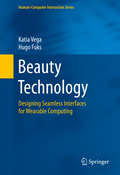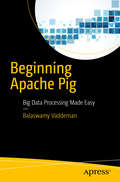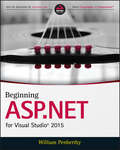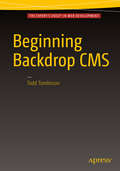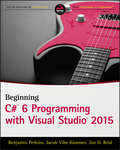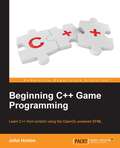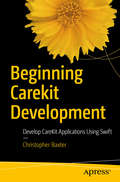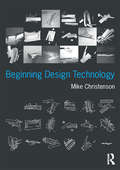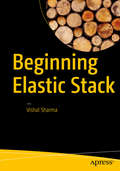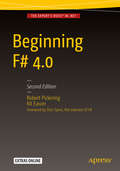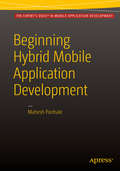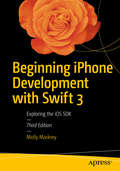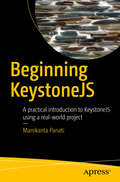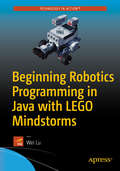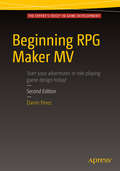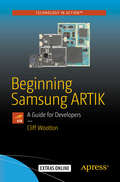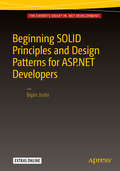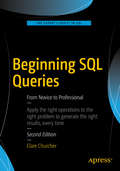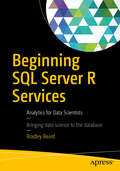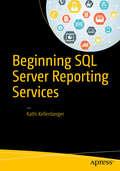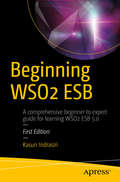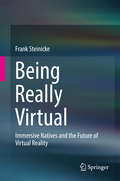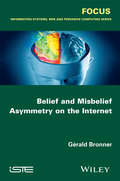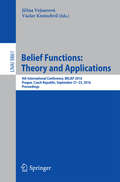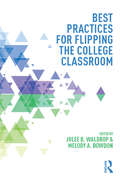- Table View
- List View
Beauty Technology: Designing Seamless Interfaces for Wearable Computing (Human–Computer Interaction Series)
by Katia Vega Hugo FuksThe increasing advances in electronics allows smaller and more powerful devices, bringing wearable computing closer to reality. However, most wearable computers are very distinguished and placed on clothes and accessories. This book tries to tackle this phenomenon by introducing a new wearable computing subfield called beauty technology. By using the body's surface as an interactive platform, the integration of technology into beauty products is explored and can be applied directly to ones skin, fingernails, and hair adding new functionality to beauty products using technology in a personal, seamless and fashionable way. An interdisciplinary approach is taken, exploring the design of Beauty Technologies such as Conductive Makeup, Tech Nails, Hairware and FX e-makeup in order to create novel interfaces for Human Computer Interaction.
Beginning Apache Pig: Big Data Processing Made Easy
by Balaswamy VaddemanLearn to use Apache Pig to develop lightweight big data applications easily and quickly. This book shows you many optimization techniques and covers every context where Pig is used in big data analytics. Beginning Apache Pig shows you how Pig is easy to learn and requires relatively little time to develop big data applications. The book is divided into four parts: the complete features of Apache Pig; integration with other tools; how to solve complex business problems; and optimization of tools. You'll discover topics such as MapReduce and why it cannot meet every business need; the features of Pig Latin such as data types for each load, store, joins, groups, and ordering; how Pig workflows can be created; submitting Pig jobs using Hue; and working with Oozie. You'll also see how to extend the framework by writing UDFs and custom load, store, and filter functions. Finally you'll cover different optimization techniques such as gathering statistics about a Pig script, joining strategies, parallelism, and the role of data formats in good performance. What You Will Learn * Use all the features of Apache Pig * Integrate Apache Pig with other tools * Extend Apache Pig * Optimize Pig Latin code * Solve different use cases for Pig Latin Who This Book Is For All levels of IT professionals: architects, big data enthusiasts, engineers, developers, and big data administrators
Beginning ASP.NET for Visual Studio 2015
by William PenberthyThe complete guide to the productivity and performance enhancements in ASP.NET Beginning ASP.NET for Visual Studio 2015 is your ultimate guide to the latest upgrade of this historically popular framework. Fully updated to align with the vNext release, this new edition walks you through the new tools and features that make your workflow smoother and your applications stronger. You'll get up to speed on the productivity and performance improvements, and learn how Microsoft has committed itself to more continuous innovation by increasing its release cadence for all products and services going forward. Coverage includes Async-aware debugging, ADO.NET idle connection resiliency, managed return value inspection, ASP.NET app suspension, on-demand large object heap compaction, multi-core JIT and more. The news of an off-cycle update to ASP.NET came as a surprise, but its announcement garnered cheers at the 2014 Microsoft BUILD conference. This guide shows you what all the fuss is about, and how Microsoft overhauled the latest ASP.NET release. Get acquainted with the new developer productivity features Master the new tools that build better applications Discover what's new in Windows Store app development Learn how Microsoft fixed the issues that kept you from v5 Over 38 million websites are currently using ASP.NET, and the new upgrade is already leading to increased adoption. Programmers need to master v6 to remain relevant as web development moves forward. Beginning ASP.NET for Visual Studio 2015 walks you through the details, and shows you what you need to know so you can get up and running quickly.
Beginning Backdrop CMS
by Todd TomlinsonLearn what Backdrop CMS is and how it fulfills the role of a content management system, along with how to install and configure it. This book teaches how to create and manage content, taxonomy, users, page layouts, and menus to get the best site possible. You'll also see how to install on shared hosting - which is a focus of the Backdrop CMS team - to make hosting your website affordable. Backdrop CMS has a very strong community, and Beginning Backdrop CMS shows you how to leverage Backdrop CMS's repository of contributed modules and themes to expand the functionality and look of your site, along with how to contribute your own material to the community. Beginning Backdrop CMS focuses on the user who is responsible for building, maintaining, and managing an organization's website and who is interested in Backdrop CMS's ability to meet their site's requirements. It covers why you should consider using a content management system when building a new web site. By reading this book, you will: Understand why you should use Backdrop CMS and the power of the platform. Build confidence in your ability to use Backdrop CMS. Gain the knowledge necessary to build, deploy, and manage web sites of moderate complexity on Backdrop CMS. Understand the process for migrating a Drupal 6 or 7 site to Backdrop CMS. What you'll learn How to install a basic Backdrop CMS web site from scratch How to create content in your new Backdrop CMS web site How to create blocks How to create and manage menus and users How to create and use layouts when creating pages on your site How to create a Backdrop CMS theme The basics of a Backdrop CMS module Who this book is for This book is for technical users who need to use Backdrop CMS to create websites using the platform, manage content, as well as developers who are new to the Backdrop CMS platform. The book is also targeted at organizations that currently use Drupal 6 or 7 and who wish to remain on the base architecture of those platforms as they move forward on Backdrop CMS.
Beginning C# 6.0 Programming with Visual Studio 2015
by Perkins Jon D. Reid Jacob Vibe HammerGet started with Visual C# programming with this great beginner's guide Beginning C# 6.0 Programming with Visual Studio 2015 provides step-by-step directions for programming with C# in the .NET framework. Beginning with programming essentials, such as variables, flow control, and object-oriented programming, this authoritative text moves into more complicated topics, such as web and Windows programming and data access within both database and XML environments. After your introduction to each of the chapters, you are invited to apply your newfound knowledge in Try it Out sections, which reinforce learning and help you understand the practical applications of the new concepts you have explored. Through this approach, you can write useful programming code following each of the steps that you explore in this essential text. Discover the basics of programming with C#, such as variables, expressions, flow control, and functions Discuss how to keep your program running smoothly through debugging and error handling Understand how to navigate your way through key programming elements, such as classes, class members, collections, comparisons, and conversions Explore object-oriented programming, web programming, and Windows programming Beginning C# 6.0 Programming with Visual Studio 2015 is a fundamental resource for any programmers who are new to the C# language.
Beginning C++ Game Programming
by John HortonLearn C++ from scratch using the OpenGL-powered SFMLAbout This BookThis book offers a fun way to learn modern C++ programming while building exciting 2D gamesThis beginner-friendly guide offers a fast-paced but engaging approach to game developmentDive headfirst into building a wide variety of desktop games that gradually increase in complexityIt is packed with many suggestions to expand your finished games that will make you think critically, technically, and creativelyWho This Book Is ForThis book is for those who have no C++ programming knowledge whatsoever and want to learn to build games or just use games as a more engaging way to learn C++. If you have aspirations of one day publishing a game on Steam or just want to have a load of fun while learning C++, then this book was written for you.What You Will LearnGet to know C++ from scratch while simultaneously learning about building gamesMake C++ game coding appear like it is something that any determined person can doGet a competent level knowledge of C++ programming.Build exciting games with a wide range of featuresGet ready to go and build your own unique gamesIn DetailThis book is all about offering you a fun introduction to the world of game programming and C++. It will begin by teaching you the programming basics such as variables, loops, and conditions using game-like mini apps.We then move on to build actual working games. Throughout the course of the book, you will learn to build three different styles of games comprising a frantic two-button-tapper, a zombie survival/shooter, and a multiplayer platformer. While building these games, you will learn some more C++ programming concepts such as OOP and data storage/complexity. We'll end by creating a multiplayer shooter game and will also introduce you to some of the advanced capabilities of C++ such as networking and advanced OOP.As the games gradually increase in complexity, you will explore some of the advanced capabilities of C++ as well as some exciting new game programming techniques.
Beginning CareKit Development: Develop CareKit Applications Using Swift
by Christopher BaxterThis book offers readers a fantastic introduction into creating CareKit based applications using the Swift language. It starts with the basics and provides a step-by-step guide to learning all aspects of creating a CareKit iOS application that could serve as the basis for a patient care plan. Beginning Carekit Development introduces the key modules and concepts of CareKit starting off by installing and building the open source framework. Developers will then dive deeper, learning how to implement their own care plan by example. The book will present an illness and complete care plan utilizing all the key modules. Readers will then be able to fully use CareKit to develop health care plans. This is the future of patient care and health tracking apps that put patients in control of their day to day care. Throughout the book, app developers, hardware manufacturers, and health care professionals will get tips and suggestions that show how to use and talk about this exciting new technology. The CareKit framework has the simple interface and the secure functionality that will change existing markets. Beginning Carekit Development is the guide to the new world of CareKit. What you'll learn: The basics of CareKit development from creating a simple "Hello World" app up to full fledged care plan application. How to integrate CareKit with HealthKit, ResearchKit, and other Apple devices to create an ecosystem of connected health care devices. How to assess and share treatment insights with caregivers and key contacts through CareKit with access to key health information. Who this book is for: Developers working in healthcare and medical device fields will use this book to develop medical apps meant to integrate directly with the ubiquitous Apple devices everyone has.
Beginning Design Technology
by Mike ChristensonBeginning Design Technology introduces how design technologies work together, including tools, materials, and software, such as Adobe Photoshop, Adobe Illustrator, Autodesk AutoCAD, and others. It teaches you how to think about each design tool, whether a software program or physical modelmaking, so that you will select one for its strengths for a specific task and know when and how to combine it with other tools. Topics include working with building information, texturing digital and physical artifacts, translating information from one form or file format to another, constructing at full-scale, and making digital and physical models. Chapter Summaries, exercises, discussion questions, a glossary, an appendix of common software commands, and an annotated bibliography will help you find what you need quickly and put the information into practice.
Beginning Elastic Stack
by Vishal SharmaLearn how to install, configure and implement the Elastic Stack (Elasticsearch, Logstash and Kibana) – the invaluable tool for anyone deploying a centralized log management solution for servers and apps. You will see how to use and configure Elastic Stack independently and alongside Puppet. Each chapter includes real-world examples and practical troubleshooting tips, enabling you to get up and running with Elastic Stack in record time. Fully customizable and easy to use, Elastic Stack enables you to be on top of your servers all the time, and resolve problems for your clients as fast as possible. Supported by Puppet and available with various plugins. Get started with Beginning Elastic Stack today and see why many consider Elastic Stack the best option for server log management.What You Will Learn:Install and configure LogstashUse Logstash with Elasticsearch and KibanaUse Logstash with Puppet and ForemanCentralize data processingWho This Book Is For:Anyone working on multiple servers who needs to search their logs using a web interface. It is ideal for server administrators who have just started their job and need to look after multiple servers efficiently.
Beginning F# 4.0
by Robert Pickering Kit EasonThis book is a great foundation for exploring functional-first programming and its role in the future of application development. The best-selling introduction to F#, now thoroughly updated to version 4. 0, will help you learn the language and explore its new features. F# 4. 0 is a mature, open source, cross-platform, functional-first programming language which empowers users and organizations to tackle complex computing problems with simple, maintainable and robust code. F# is also a fully supported language in Visual Studio and Xamarin Studio. Other tools supporting F# development include Emacs, MonoDevelop, Atom, Visual Studio Code, Sublime Text, and Vim. Beginning F#4. 0 has been thoroughly updated to help you explore the new features of the language including: Type Providers Constructors as first-class functions Simplified use of mutable values Support for high-dimensional arrays Slicing syntax support for F# lists Reviewed by Don Syme, the chief architect of F# at Microsoft Research, Beginning F#4. 0 is a great foundation for exploring functional programming and its role in the future of application development. What you'll learn A deep familiarity with the tenets and advantages of functional programming. How to understand F# 4. 0's concise and elegant syntax. How to develop for real-world scenarios using functional programming and F# 4. 0. How to develop realistic applications through a comprehensive tutorial-based approach. How to learn imperative and concurrent programming techniques within the functional programming paradigm. Who this book is for Beginning F# 4. 0 is for anyone interested in state-of-the-art programming for solving real-world problems. It serves as an excellent introduction to F# for programmers of all backgrounds including C#, Java and VB as well as for lovers of Python, Ruby and other dynamic languages. If you are already familiar with functional programming, you'll find Beginning F#4. 0 a great introduction to the language itself. If you are new to the function programming arena, this book will also serve as a superb reference to FP in general and F# specifically.
Beginning Hybrid Mobile Application Development
by Mahesh PanhaleToday, a mobile device user prefers installed application over browsing internet; e. g. booking cab, buying movie tickets, watching you tube videos etc. Market share of mobile devices based on android, iOS & Windows Phone is considerable. Creating an installable application targeting these multiple devices involves too much of pain because of expertise required e. g. Java for android, Objective C for iOS and DotNET for Windows Phone. Shortcomings of this development approach are - more development time, it requires different expertise & involves less reusability of the code. A solution to this problem is HTML 5, JQuery, CSS 3 based - Hybrid Mobile Applications . These hybrid applications needs to be created once but after packaging can be deployed on multiple mobile devices like Android, iOS & Windows Phone. This kind of application development has edge over native application development. Beginning Hybrid Mobile Application Development by Panhale can help each entity involved in mobile application development. With availability of multiple coding and packaging platforms; HMAD has even become more easy. Since HMAD happens in HTML & Javascript it's even possible that with small effort conditionally; existing web application can be converted into mobile based application. HMAD can give larger audience for many web applications by making it available as mobile application. This book covers: Basics of Hybrid Application Development Platforms, Frameworks used for Hybrid Application Development Internals of how hybrid applications work Hybrid Application Development using available APIs Accessing data in hybrid application Role of JSON over XML in hybrid application Code Security This book will change the paradigm of mobile application development as the efforts are less, learning curve is small, success ratio is high and monetary benefit is on higher side! What you'll learn How to create, package, test & deploy hybrid mobile application step by step How to solve issues while accessing device specific features How to establish synergy between web application & mobile application Insight to advertisement frameworks in hybrid applications How to secure code in hybrid application Who this book is for Mobile application developers for Android, iOS, Windows Phone architects, and technical managers. Table of Contents Introduction to Mobile Application Development (MAD) Getting Started Building blocks of HMAD Creating first Hybrid Application HMAD: Internals Data Access in HMAD UI for HMAD Using device specific features in HMAD How to advertise with HMAD Working with third party services in HMAD Setup and Deployment XAMARIN vs HMAD! Case Study: Practical Approach
Beginning iPhone Development with Swift 3: Exploring the iOS SDK
by Kim Topley David Mark Jeff Lamarche Fredrik Olsson Molly MaskreyCreate your very own apps for the latest iOS devices. You'll start with the basics, and then work your way through the process of downloading and installing Xcode and the iOS 10 SDK, and then guides you though the creation of your first simple application. Assuming little or no working knowledge of the Swift programming language, and written in a friendly, easy-to-follow style, Beginning iPhone Development with Swift 3 offers a comprehensive course in iPhone and iPad programming. In this third edition of the best-selling book, you'll learn how to integrate all the interface elements iOS users have come to know and love, such as buttons, switches, pickers, toolbars, and sliders. Every single sample app in the book has been rebuilt from scratch using the latest Xcode and the latest iOS 10-specific project templates, and designed to take advantage of the latest Xcode features. Discover brand-new technologies, as well as significant updates to existing tools. You'll master a variety of design patterns, from the simplest single view to complex hierarchical drill-downs. The art of table building will be demystified, and you'll learn how to save your data using the iOS file system. You'll also learn how to save and retrieve your data using a variety of persistence techniques, including Core Data and SQLite. And there's much more! What You Will Learn Develop your own bestselling iPhone and iPad apps Utilize Swift playgrounds Display data in Table Views Draw to the screen using Core Graphics Use iOS sensor capabilities to map your world Get your app to work with iCloud and more Who This Book is For Anyone who wants to start developing for iPhone and iPad.
Beginning KeystoneJS: A practical introduction to KeystoneJS using a real-world project
by Manikanta PanatiLearn how to develop a complete and robust Node, express. js and MongoDB-based web application and mobile application backend quickly using KeystoneJS. You'll learn how KeystoneJS makes complicated things simple, without limiting the power or flexibility of node. js or the frameworks it is built on. Beginning KeystoneJS shows you how to build database-driven websites, applications, and APIs, all built upon Express, the defacto web server for Node. js that uses MongoDB as its storage backend. What You Will Learn Discover the setup and architecture of the KeystoneJS framework. See how easy it is to extend KeystoneJS Understand the custom types and fields provided out of the box Write clean markup and create templates using Swig Use the powerful editing options in the framework's responsive dashboard Who This Book Is For Technical and non-technical people who would like to build applications quickly to leverage structured data to improve productivity.
Beginning Robotics Programming in Java with LEGO Mindstorms
by Wei LuDiscover the difference between making a robot move and making a robot think. Using Mindstorms EV3 and LeJOS--an open source project for Java Mindstorms projects--you'll learn how to create Artificial Intelligence (AI) for your bot. Your robot will learn how to problem solve, how to plan, and how to communicate. Along the way, you'll learn about classical AI algorithms for teaching hardware how to think; algorithms that you can then apply to your own robotic inspirations. If you've ever wanted to learn about robotic intelligence in a practical, playful way, Beginning Robotics Programming in Java with LEGO Mindstorms is for you. What you'll learn: Build your first LEGO EV3 robot step-by-step Install LeJOS and its firmware on Lego EV3 Create and upload your first Java program into Lego EV3 Work with Java programming for motors Understand robotics behavior programming with sensors Review common AI algorithms, such as DFS, BFS, and Dijkstra's Algorithm Who this book is for: Students, teachers, and makers with basic Java programming experience who want to learn how to apply Artificial Intelligence to a practical robotic system.
Beginning RPG Maker MV
by Darrin PerezCreate your very own role playing game using the RPG Maker MV game development engine. You'll go through tutorials and exercises that will take you from installing the software to putting the final touches upon your first project. Beginning RPG Maker MV has been designed with the complete beginner in mind who has little to no experience with the engine. It includes full JavaScript code, replacing the old Ruby commands. Game design can be quite a daunting challenge, as it generally involves a large amount of programming know-how on top of having to plan everything out that makes a good game what it is. RPG Maker MV is an intuitive system that allows you to make your own game with a fraction of the effort otherwise required. Beginning RPG Maker MV equips you with the knowledge you need to use Enterbrain's newest role playing game development engine. Takes you from the start of a project to the completion of a small game. Provides a step-by-step process that will walk you through each stage of the creation process. Gives many helpful tips and tricks you can apply to your future endeavors with the engine. What you'll learn Use switches and variables to affect the game world Populate your areas with non-player characters that serve a wide range of roles Use the database which serves as the backbone of RPG Maker MV Create dungeons with two types of enemy encounter Create fun and varied mini-games and side-quests to serve as distractions from the main plot Write scripts using RPG Maker MV's Script Editor Who this book is for Beginning RPG Maker MV is for novices in game design who would like to learn how to use a simple, yet robust, game development engine. It's for those people who have little to no programming experience but would like to make an RPG.
Beginning Samsung ARTIK: A Guide for Developers
by Cliff WoottonSamsung's announcement of its new ARTIK(tm) modules for IoT has generated tremendous interest in the developer market for wearables and other consumer and industrial devices. This book provides the perfect tutorial-based introduction to the ARTIK family of "Systems on Modules," which integrate powerful microprocessors, memory, wireless connectivity, and enhanced security on to very small form factor boards. Beginning Samsung ARTIK will help you understand which ARTIK modules to use for various applications, and how to produce code for them. This book goes beyond the information previously available online, efficiently guiding developers from initial setup of their development environment to product development and prototyping in no time. Helpful background insights into foundation technology is provided for beginners and useful reference information is included for more advanced developers. With Beginning Samsung ARTIK as your guide, take the next steps to creating great solutions with an ARTIK. What you'll learn Use terminal emulators to access the command line and talk to the device Establish Wi-Fi connectivity with a wireless network Upgrade the operating system and install additional software Bring up Eclipse IDE and create a cross-compiler toolchain on Mac OS X Use Arduino IDE with libArduino to cross-compile for the ARM processors in the ARTIK modules Use C language to access the ARTIK hardware via a file based API Use Node. js & Python inside the ARTIK module Integrate applications with the Samsung SAMI data aggregation hub Use Temboo to generate IoT software solutions that can be downloaded and compiled natively inside the ARTIK Debug applications with software and hardware probes Who this book is for The book is designed to serve moderately experienced developers wanting to understand Artik and how to interact with it from within their own apps or web services.
Beginning SOLID Principles and Design Patterns for ASP.NET Developers
by Bipin JoshiThis book teaches you all the essential knowledge required to learn and apply time-proven SOLID principles of object-oriented design and important design patterns in ASP. NET 5 (recently renamed ASP. NET Core 1. 0) applications. You will learn to write server-side as well as client-side code that makes use of proven practices and patterns. SOLID is an acronym used to describe five basic principles of good object-oriented design--Single Responsibility, Open/Closed, Liskov Substitution, Interface Segregation and Dependency Inversion. This book covers all five principles and illustrates how they can be used in ASP. NET 5 applications. Design Patterns are time proven solutions to commonly occurring software design problems. The most well-known catalog of design patterns comes from Erich Gamma, Richard Helm, Ralph Johnson and John Vlissides, the so-called GoF patterns (Gang of Four patterns). This book contains detailed descriptions of how to apply Creational, Structural and Behavioral GoF design patterns along with some Patterns of Enterprise Application Architecture. Popular JavaScript patterns are covered, along with working examples of all these patterns in ASP. NET 5 and C# are included. * How to apply SOLID principles to ASP. NET 5 applications What you'll learn * How to use Gang of Four (GoF) design patterns in ASP. NET 5 applications * Techniques for applying Patterns of Enterprise Application Architecture cataloged by Martin Fowler in ASP. NET 5 applications * How to organize code and apply design patterns in JavaScript Who this book is for This book is for ASP. NET developers familiar with ASP. NET 5, C# and Visual Studio. Table of Contents 1. Overview of SOLID Principles and Design Patterns 2. SOLID Principles 3. Creational Patterns - Singleton, Factory Method and Prototype 4. Creational Patterns - Abstract Factory and Builder 5. Structural Patterns - Adapter, Bridge, Composite and Decorator 6. Structural Patterns - Façade, Flyweight and Proxy 7. Behavioral Patterns - Chain of Responsibility, Command, Interpreter and Iterator 8. Behavioral Patterns - Mediator, Memento and Observer 9. Behavioral Patterns - State, Strategy, Template Method and Visitor 10. Patterns of Enterprise Application Architecture - Repository, Unit of Work, Lazy Load and Service Layer 11. JavaScript Code Organization Techniques and Patterns
Beginning SQL Queries: From Novice to Professional
by Clare ChurcherClare Churcher s Beginning SQL Queries is your guide to mastering the lingua franca of the database industry: the SQL language. Good knowledge of SQL is crucial to anyone working with databases, because it is with SQL that you retrieve data, manipulate data, and generate business results. Knowing how to write good queries is the foundation for all work done in SQL, and it is a foundation that Clare lays well in her book. Does not bore with syntax Helps you learn the underlying concepts involved in querying a database, and from there the syntax is easy Provides exceptionally clear examples and explanations Is academically sound while being practical and approachable"
Beginning SQL Server R Services: Analytics for Data Scientists
by Bradley BeardLearn how to develop powerful data analytics applications quickly for SQL Server database administrators and developers. Organizations will be able to sift data and derive the business intelligence needed to drive business decisions and profit. The addition of R to SQL Server 2016 places a powerful analytical processor into an environment most developers are already comfortable with - Visual Studio. This book walks even the newest of users through the creation process of a powerful R-language tool set for use in analyzing and reporting on your data. As a SQL Server database administrator or developer, it is sometimes difficult to stay on the bleeding edge of technology. Microsoft's addition of R to SQL Server 2016 is sure to be a game-changer, and the language will certainly become an integral part of future releases. R is in fact widely used today in statistical and related applications, and its use is only growing. Beginning SQL Server R Services helps you jump on board this important trend by providing good examples with detailed explanations of the WHY and not just the HOW. Walks you through setup and installation of SQL Server R Services. Explains the basics of working with R Tools for Visual Studio. Provides a road map to successfully creating custom R code. What You Will Learn Discover R's role in the SQL Server 2016 hierarchy. Manage the components needed to run SQL Server R Services code. Run R-language analytics and queries inside the database. Create analytic solutions that run across multiple datasets. Gain in-depth knowledge of the R language itself. Implement custom SQL Server R Services solutions. Who This Book Is For Any level of database administrator or developer, but specifically it's for those developers with the need to develop powerful data analytics applications quickly. Seasoned R developers will appreciate the book for its robust learning pattern, using visual aids in combination with properties explanations and scenarios. Beginning SQL Server R Services is the perfect "new hire" gift for new database developers in any organization.
Beginning SQL Server Reporting Services
by Kathi KellenbergerLearn SQL Server Reporting Services and become current with the 2016 edition. Develop interactive, dynamic reports that combine graphs, charts, and tabular data into attractive dashboards and reports to delight business analysts and other users of corporate data. Deliver mobile reports to anywhere and any device. Build vital knowledge of Reporting Services at a time when Microsoft's dominance in business intelligence is on the rise. Beginning SQL Server Reporting Services turns novices into skilled report developers. The book begins by explaining how to set up the development environment. It then walks you through creating your first reports using the built-in wizard. After showing what is possible, the book breaks down and explains the skills needed to create reports from scratch. And not just reports! But also dashboards with charts, graphs, and maps. Each chapter builds on knowledge gained in the previous chapters with step-by-step tutorials. Beginning SQL Server Reporting Services boosts your skills and provides you additional career options. Don't be without those options. Grab and read this book today. Build reports with and without the built-in wizard. Build interactive features such as drill-through reports. Build dashboards full of charts, graphs, and maps. Build mobile reports. What You Will LearnSet up your development environment.Organized projects and share components among reports.Create report using a wizard.Create reports from scratch, including grouping levels, parameters, and drill through features.Build interactive dashboard with graphs, charts, and maps.Deploy and manage reports for use by others in the business. Who This Book Is ForDatabase professionals of all experience levels who have some experience in databases and want to make the leap into business intelligence reporting. The book is an excellent choice for those needing to add Reporting Services to their current list of skills, or who are looking for a skill set that is in demand for in order to break into IT.
Beginning WSO2 ESB
by Kasun IndrasiriGain a strong foundation of core WSO2 ESB concepts and acquire a proven set of guidelines designed to get you started with WSO2 ESB quickly and efficiently. This book focuses on the various enterprises integration capabilities of WSO2 ESB along with a broad range of examples that you can try out. From beginning to the end, Beginning WSO2 ESB effectively guides you in gradually building expertise in enterprise integration with WSO2 ESB for your SOA infrastructure. Nowadays successful enterprises rely heavily on how well the underlying software applications and services work together to produce a unified business functionality. This enterprise integration is facilitated by an Enterprise Service Bus (ESB). This book provides comprehensive coverage of the fundamentals of the WSO2 ESB and its capabilities, through real-world enterprise integration use cases. What You'll Learn Get started with WSO2 ESB Discover message processing techniques with WSO2 ESB Integrate REST and SOAP services Use enterprise messaging techniques: JMS, AMQP, MQTT Manage file-based integration and integrate with proprietary systems such as SAP Extend and administrate WSO2 ESB Who This Book Is For: All levels of IT professionals from developers to integration architects who are interested in using WSO2 ESB for their SOA infrastructure.
Being Really Virtual: Immersive Natives and the Future of Virtual Reality
by Frank SteinickeThis book focuses on the recent developments of virtual reality (VR) and immersive technologies, what effect they are having on our modern, digitised society and explores how current developments and advancements in this field are leading to a virtual revolution. Using Ivan Sutherland's 'The Ultimate Display' and Moore's law as a springboard, the author discusses both popular scientific and technological accounts of the past, present and possible futures of VR, looking at current research trends, developments, challenges and ethical considerations to the coming age of differing realities. Being Really Virtual is for researchers, designers and developers of VR and immersive technologies and anyone with an interest in the exponential rise of such technologies and how they are changing the very way we perceive, interact and communicate within our digital society.
Belief and Misbelief Asymmetry on the Internet
by Gérald BronnerThis book discusses the media, beliefs, the news, the Internet, etc. but it should not be seen as yet another critique of the media system, exploring with indignant fascination the idea of a machination against truth set up to serve a society of domination. These kinds of theories, whether they pertain to conspiracy theories or, more subtly, to a self-styled “critical” way of thinking, have always seemed to be the expression of a form of intellectual puerility. This is not to say that attempts at manipulating opinions do not occur, or that our world is free from compromised principles, or indeed corruption; far from it, but none of this is the key issue. In fact, reality can somehow be even more unsettling than those myths, however sophisticated they may be, that envisage the media system hand-in-hand with industry, science, and so forth, all in agreement so as to lead the “people” away from the truth. It is more unsettling because the processes described in this book and that allow falsehood and dubiousness to take hold of the public sphere are boosted by the development of IT, the workings of our minds, and the very nature of democracy. And finally, it is more unsettling because we are all responsible for what is going to happen to us.
Belief Functions: 4th International Conference, BELIEF 2016, Prague, Czech Republic, September 21-23, 2016, Proceedings (Lecture Notes in Computer Science #9861)
by Jiřina Vejnarová Václav KratochvílThis book constitutes the thoroughly refereed proceedings of the 4th International Conference on Belief Functions, BELIEF 2016, held in Prague, Czech Republic, in September 2016. The 25 revised full papers presented in this book were carefully selected and reviewed from 33 submissions. The papers describe recent developments of theoretical issues and applications in various areas such as combination rules; conflict management; generalized information theory; image processing; material sciences; navigation.
Best Practices for Flipping the College Classroom (Best Practices in Online Teaching and Learning)
by Julee B. Waldrop Melody A. BowdonBest Practices for Flipping the College Classroom provides a comprehensive overview and systematic assessment of the flipped classroom methodology in higher education. The book: Reviews various pedagogical theories that inform flipped classroom practice and provides a brief history from its inception in K–12 to its implementation in higher education. Offers well-developed and instructive case studies chronicling the implementation of flipped strategies across a broad spectrum of academic disciplines, physical environments, and student populations. Provides insights and suggestions to instructors in higher education for the implementation of flipped strategies in their own courses by offering reflections on learning outcomes and student success in flipped classrooms compared with those employing more traditional models and by describing relevant technologies. Discusses observations and analyses of student perceptions of flipping the classroom as well as student practices and behaviors particular to flipped classroom models. Illuminates several research models and approaches for use and modification by teacher-scholars interested in building on this research on their own campuses. The evidence presented on the flipped classroom methodology by its supporters and detractors at all levels has thus far been almost entirely anecdotal or otherwise unreliable. Best Practices for Flipping the College Classroom is the first book to provide faculty members nuanced qualitative and quantitative evidence that both supports and challenges the value of flipping the college classroom.
